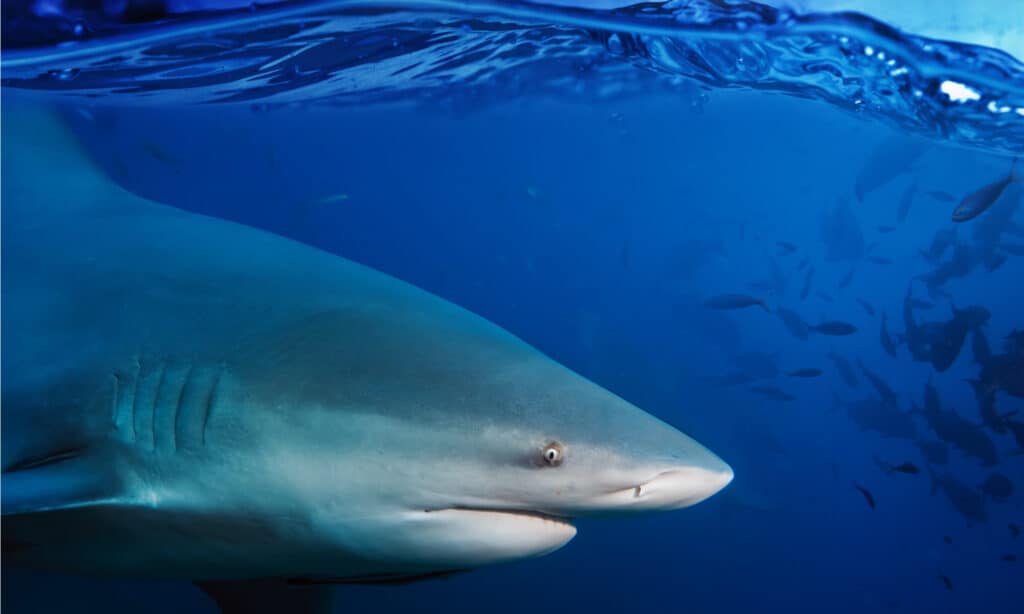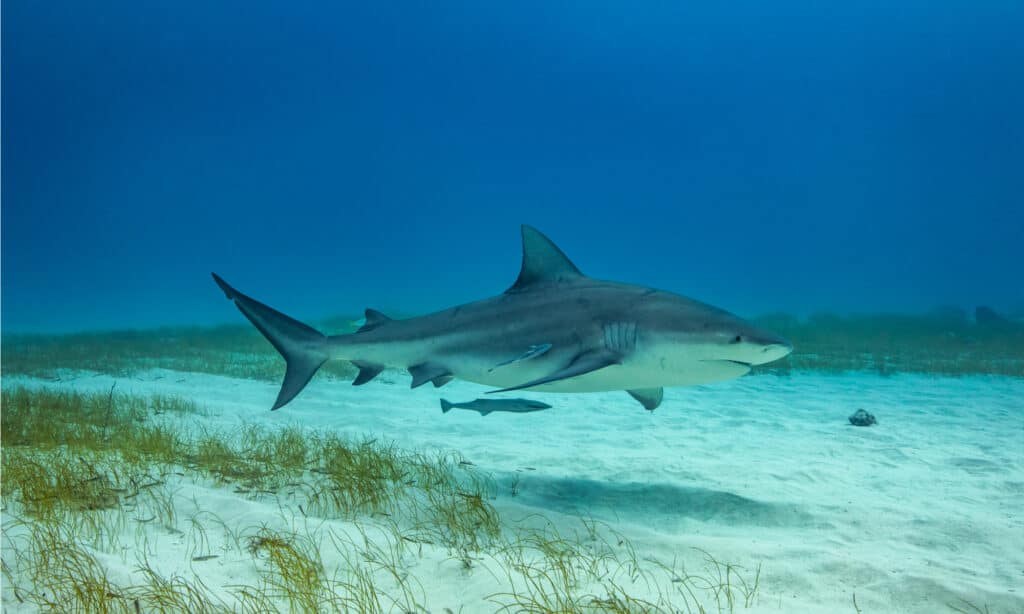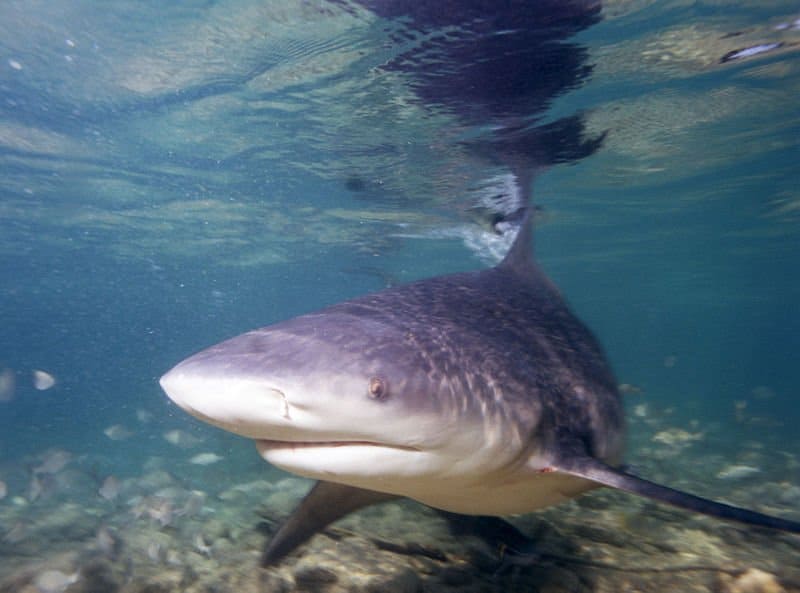The Mississippi River is the second-longest river in the US! It is 2,350 miles long, flowing south towards the Mississippi River Delta. This river crosses 10 U.S. states and is home to approximately 375 fish species, including walleye, largemouth bass, white bass, and common shiner. Alligators, aquatic amphibians, and turtles also inhabit the river’s ecosystem.
But would you believe us if we told you that sharks also lived (and still do) in the Mississippi River? It might sound crazy, but the evidence says otherwise. How can they survive in freshwater habitats, right?! And most importantly, how did they end up in the Mississippi River?
Check out this article to learn everything there is to know about sharks in the Mississippi River!

Are There Sharks in the Mississippi River?

Bull sharks and bull shark fossils and their teeth have been found in the Mississippi River.
©Martin Prochazkacz/Shutterstock.com
Bull sharks have been spotted in the Mississippi River. Moreover, mainly bull shark fossils and teeth have been discovered there too. However, the first bull shark catches and sightings date from the 20th century. Herbert Cope and Dudge Collins were the first to catch a bull shark in the Mississippi River. It happened in September 1937 in Alton, Illinois. The shark was 5 feet long and weighed 84 pounds.
Another bull shark was spotted in St. Louis, Missouri, in 1995. It was seen near Rush Island Power Station. The shark was stuck in the grate of an intake canal.
Even though there are only two officially confirmed bull shark catches and sightings, there may be many more individuals in the area. For example, in 2021, some anglers caught several juvenile sharks in the Mississippi River near Fort Jackson, Louisiana. Who knows how many are out there in the Mississippi waters?!
Why Can Bull Sharks Live in the Mississippi River?

Bull sharks can survive in freshwater environments because their bodies can balance the salt levels.
©Willyam Bradberry/Shutterstock.com
Even though sharks are generally known to inhabit saltwater habitats, bull sharks can survive in freshwater environments too. This happens because their bodies can balance the salt levels. Bull sharks absorb salt from saltwater environments. Then, their bodies recycle the salt when they move into freshwater habitats. Their rectal gland, liver, kidneys, and gills are responsible for maintaining the required salt and water balance. Sharks that can live in both saltwater and freshwater habitats are called diadromous.
How Did Bull Sharks End Up in the Mississippi River?
A study says that sharks have been spotted in freshwater ecosystems worldwide, which is not a recent phenomenon. Paleontologists found river shark fossils dating to the Miocene Epoch, suggesting that they adapted to the river’s ecosystem long ago. Moreover, fossil records indicate that other sharks lived in rivers, too, as bull shark teeth fossils were found alongside white shark fossils and other Miocene-Pliocene sharks, including Isurus hastalis, Carcharocles megalodon, and Hemipristus serra. But why and how did they end up in the Mississippi River? Scientists provide three explanations, although all are hypothetical.

Bull shark teeth fossils were found alongside white shark fossils and other Miocene-Pliocene sharks.
©Igor Kovalchuk/Shutterstock.com
First, they might have developed this swimming pattern far upstream to explore the area. Second, considering how often bull sharks have been spotted in rivers worldwide, scientists think this movement pattern is deeply rooted in their evolutionary history. Third, they end up in rivers by mistake. This theory implies that such events are “rare and anomalous,” especially considering that only two bull sharks were caught in the Mississippi River.
While the first and second hypotheses may go hand in hand, as they both suggest that bull sharks have been roaming in the Mississippi River for millions of years, the third explanation excludes the first two. Scientists haven’t decided between the three because the discovered fossils are recent, but this doesn’t mean they haven’t been around. If they’ve “exhibited” cryptic movement, which means that they reached the river without leaving any traces, they could’ve lived in the ecosystem without anyone finding out about it.
What Do Bull Sharks Look Like, and What Do They Eat?

Bull sharks are gray on top and white on the underside.
©Carlos Grillo/Shutterstock.com
Bull sharks are also known as “Lake Nicaragua sharks” and “Zambezi sharks.” They are a large species, with females reaching 11 feet long and males reaching 7 feet long. However, the maximum recorded bull shark size is 13 feet long. An adult bull shark’s average weight is between 200 and 500 pounds.
Zambezi sharks are gray on top and white on the underside. Juvenile sharks have dark tips on their fins. They have two dorsal fins, the second being smaller than the first. Bull sharks don’t have an inter-dorsal ridge, and their snout is small. They have big, triangular teeth with serrated edges. These sharks have small eyes, indicating they don’t have good eyesight.
Here’s what bull sharks eat:
- Turtles;
- Dolphins;
- Birds;
- Terrestrial mammals;
- Small sharks;
- Crustaceans;
- Echinoderms.
Have There Been Shark Attacks on the Mississippi River?

There aren’t any confirmed bull shark attacks on the Mississippi River.
©Havoc/Shutterstock.com
Even though bull sharks are considered the third-most aggressive sharks in the world, there aren’t any confirmed bull shark attacks on the Mississippi River. Since sharks have rarely been spotted, attacks are unlikely to happen in the river. That’s because they rarely attack people unprovoked. Suppose the explanation provided by scientists — that bull sharks have developed cryptic movement so that people didn’t spot them in rivers. In that case, this might also explain why there aren’t any official shark attack records on the Mississippi River.
However, we can’t be sure no one was ever attacked in the river’s ecosystem, as there may be unofficial or unconfirmed incidents. Bull sharks’ poor visibility indicates that they hunt in places with plenty of prey and where eyesight is not crucial. So if they do attack people, this likely happens in shallow muddy waters.

Bull sharks have traveled at least 1,740 miles up the Mississippi River.
©Albert Kok, CC BY-SA 3.0, via Wikimedia Commons – License
How Far Have Bull Sharks Traveled Up the Mississippi River?
A recent study has proven that bull sharks have traveled over 1,000 miles up the Mississippi River. The first confirmed report was in September of 1937 near Alton, Illinois, and involved two fishermen who pulled up bait traps to find them destroyed by a mysterious big fish. They set another big trap to catch the culprit and pulled up a dead bull shark that had been caught in the trap — 1,740 miles from the Gulf of Mexico!
A second bull shark was found stuck in the grate of an intake canal in 1995 at the Rush Island Power Station in Festus, Missouri, 900 miles from the gulf. Some believe these incidents to be random but the researchers think otherwise. It appears that bull sharks are totally capable of traveling down the river so far and have been doing so for years!
See Some Anglers Catching Baby Sharks in the Mississippi River!
Check out this YouTube video, which shows Mark Hood and other anglers catching several baby sharks in the Mississippi River near Fort Jackson, Louisiana. They caught three sharks and then released them back into the water. Mark Hood almost caught a fourth large fish, but it managed to escape and swim back into the water.
The fact that these anglers managed to catch so many sharks near Fort Jackson indicates that many individuals inhabit the area. However, most of them are likely juvenile bull sharks, as they are born with a low tolerance for high salinity. They stay in freshwater environments until they are old enough to travel long distances to reach saltwater.
The photo featured at the top of this post is © iStock.com/Divepic
Thank you for reading! Have some feedback for us? Contact the AZ Animals editorial team.






